Dear pagan readers,
Let me present you a plant whose nowadays reputation is far from what is used to be in pagan times. It is now mostly cursed as one of the main weed, being considered the plague of the golf courses, parks and gardens. But let me tell you that the greatest European pharmacologists, botanists and herbalists of antiquity had it in great esteem. And for good reasons of course.
In Greek mythology, it is even a part of one of the most well known myth; the goddess Ἑκάτη, widely known as Hecate, fed Θησεύς, the hero known as Theseus, with this sacred plant for 30 days, giving him enough strength to defeat the Μῑνώταυρος(Minotaur) in the Cretan Labyrinth – testament indeed to the value of this excellent herb! This plant led the Greek Hero Theseus to victory in his pagan initiation and let him cultivate his Hamingja to a full potential. I will elaborate deeper about the undeniable link between this myth and Ôðalism in a future article.
This is a plant many of us know well, or at least, most think they know it well. This plant is called Taraxacum officinale in Latin, it is the Common Dandelion. From French dent-de-lion (“lion’s tooth”), also in Late Latin dēns leōnis. The term has since died out in French (except in Swiss French), but compare Spanish diente de león, Italian dente di leone, Norwegian løvetann, Portuguese dente-de-leão, and also German Löwenzahn, all having the same literal meaning. It is called after the shape of the leaves that looks like lion’s teeth. Some say the Latin name comes from the Greek ταράξω(taráxo̱), meaning ”disorder”, and ἄκος(akos), meaning ”remedy”.
Πεδάνιος Διοσκουρίδης, one of my main influence regarding Herbalism, better known as Pedanius Dioscorides, mentioned the Dandelion in is gigantic five volume encyclopaedia called Περί ύλης ιατρικής(De Materia Medica Libre).
Dandelion is a rich source of vitamins A, B complex, C, and D, as well as minerals such as iron, potassium, and zinc. Dandelion leaves can be used to add flavor to salads, sandwiches, and teas. The roots can be used in some coffee substitutes, and the flowers can be used to make wines.
As you might have understand, Dandelion is not a weed, but a wild vegetable, more nutritious than the broccoli or spinach that cleanse the blood and kidneys, reduces gas, blood pressure, fat and cholesterol and increases muscular strength, all this without side effects. In medicine, the roots are mainly used as an appetite stimulant, and for liver and gallbladder problems and the leaves are used as a diuretic to help the body get rid of excess fluid.
You can harvest the leaves and flowers from spring until autumn. About the roots, I mentioned that Hecate fed Theseus with Taraxacum officiale, and therefore the best time to gather the root is in November, the month of Hecate. If you live in a northern area, it must be harvested a little bit earlier as the snow and cold weather are coming earlier.
As European folks, how can you turn your back on the magic herb given by the night goddess to Theseus, thus making him one of our famous European hero? Will you be such a hero yourself? Will you gain your Hamingja? Let’s begin by thanking the Goddess Hecate for her precious gift by making good use of it! So enjoy!
Frederik Blanchet

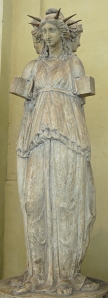
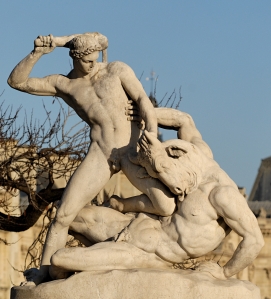
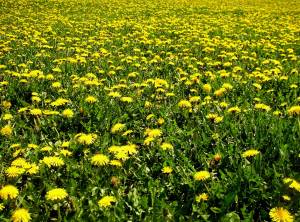
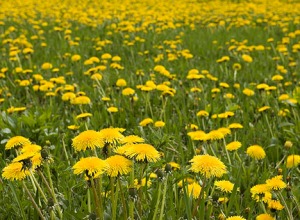
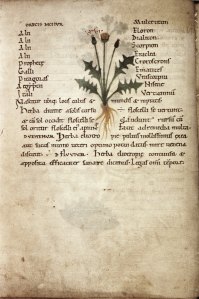



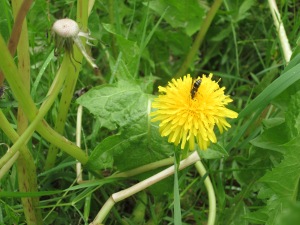
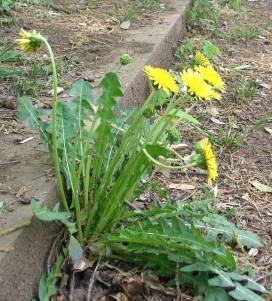

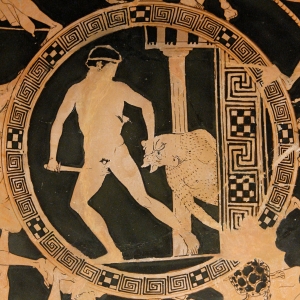
A wonderful plant and plentiful, my yard is full of them right now. My father used to make Dandelion tea from when I was very young when we used to go camping. Wonderful unappreciated plant of naive people to curse it.
Let them curse it. Blow it everywhere when it’s seeding! 😉
Indeed haha! Some people have been skeptical at best to the benefits of the flower, but I know myself of it’s benefits. All the more for us 😉
Reblogged this on Vinland Shore.
It’s called ‘lion’s tooth’ (løvetann) in Norwegian too, by the way.
We eat the leaves a lot here in France, for salads. You need to eat it when it is young, or else it tastes… not so good.
I’ll try the roots and flower too. Because of your post. Thanks!
You’re welcome! About løvetann, yes, I mentioned it in the third paragraph 😉
Ah… I missed that.
No problem, it is probably pretty late in the evening in France right now… 😉
About the bitter taste of the mature leaves, you’re right. But I find it easy to fit it in many plates when mixed with specific ingredient… Still it taste way better when it’s young, especially in salads…
Reblogged this on Thulean Perspective.
Very interesting. When I was young I used to try and save the dandelions when my dad would go out picking weeds or mowing. Now it all makes sense, subconsciously I must have known about the health benefits of the plant and wanted it as I ate pretty poorly as a child.
You should have ate it much and more often back then. Now let’s not make the same mistake! Try it!
My step mother puts it in salad a lot. Its not bad.
I get a ton of these on my property. I will need to take your advice. Thank you for this article!
You’re welcome my friend.
Ah, yes my favourite enduring plant, also known as a weed by those not in the know. One can make dandelion wine too with the flowers.
Dandelion milk contains Taraxine and you can rub the white milk from the stem on nettle stings, warts, pimples or (sun) burns to soften the skin, it’s very effective. It’s called a Horseflower in my native tongue, I guess horses eat them too…
sorry Horseflower means useless flower in my language; other names include Hynsteblom, Dogstongue, Rabbitleaf and Pissflower, not very poetic either.
Nowadays it is called ”Pissenlit” in French, meaning ”pee in bed”.
Great article, though one thing you have to watch for, especially in more urban areas, is chemical treatment on a lot of them. Since they are (wrongly) thought of as a weed many of them are contaminated with pesticides.
With herbicide such as glyphosate(roundup), the plant dies within a few hours. And anyway, I would never eat a plant growing in urban areas…
Thanks, good to know, and I meant for people living in those areas that might try them. It is always wise to stay away from any “food” in the cities.
Reblogged this on Virðing.
Hey, glad to see you post about this. If you can remember the video I posted a while ago.
I can tell you, the dandelions here in the Rockies are blossoming and growing. Not so much at all back at the swamps.
Thanks for this post.
You’re welcome my friend. by the way, have you managed to find and identify with certainty the Plantago??
Yes I have. Excuse the foolish behaviour I had about it when you had made that post. I was a little new to all of this.
I did munch on some last night on the summit of the Flatirons over here, and I’ve got to say it was a great time and I felt very accomplished.
So thank you, Frederik.
So you are back in colorado if I understood well? Is there less mosquito and flies compared to Louisiana? Probably with all the swamp…
I would think my uncle lives out that way in the mountains. Lots of wild fires though. But its over all not as bad as parts of the south. Rural Virginia is good I think. I prefer the North more, I like the Cold.
We used to pick a lot of these with my grandfather when I was younger and make soup out of them. I remember that I liked it more than spinach soup.
Would you please write me an e-mail? wood.maiden@yahoo.de
I have to ask you something.
Very good article Frederik and thank you. I like your articles on plants very much. Here grow a lot of this plant, and due to your article I will start not to ignore it but will use it in food instead. But I have some questions about the flower of this plant: Is the flower good to eat (fresh)? May the flower be dried and used for the tea? The stem can be eaten too?
I
Some makes a pretty restrain use of it. They only eat the leaves in salad or in soup. But let me tell you there’s no limit with the use of dandelion as there’s no side effects. Eat it however you want, try and invent recipes, it’s all for your own good, even if it doesn’t taste good 😉 And yes, I have seen folks eating the flower and use it for tea… Personally, I even eat the mature leaves(very bitter taste) as dessert after a plate with lot of acidity. It balance my body pH…
Cool. That’s a really wonderfull plant. Thank thee Frederik.
Reblogged this on Aryan Renaissance.
Oh, I have a question.
How do I prepare it? Is it roasted? dried? boiled? eaten raw?
How do I eat it?
Thanks again.
Another question, will cooking it kill the good nutrients in it? That’s only what I’m concerned about.
Roasted most likely it would kill the nutrients, but boiled it is not a problem, except that you have to use the bouillon instead of wasting it because a lot of vitamins are released in the water when boiled…
Raw in salads or sandwiches, boiled in soup and stew, dried for teas. There’s so many way to use it in the kitchen. Be imaginative and don’t be shy to try new things, then you’ll probably find something very good to do with it that nobody ever tried before. Personally, I found that it taste very good in cold meat sandwich with honey mustard, even with mature leaves which taste very bitter. Both together, it makes a perfect equilibrium…
I just diced it up and put in on a baked potato with barbecue sauce and some aromat, which I got from the Swiss friend I am staying with.
Very good! Thank you again for both the replies and the post.
Great article!
Here some fields are fully blossomed with these flowers: I think I will try to use them for the nutritional purposes you mentioned.
My parents-in-law have recently sprayed some anti-weed stuff into the grass to keep their domesticated lawn, now I can’t pick it up from our garden anymore. But fortunately it grows everywhere 🙂 Thank you, it was so clear that this plant must be good for something important…
Tell your parents-in law not to use herbicides. No more. It is highly carcinogenic. And barely all the supposed ”weeds” growing in the lawn are medicinal plants. So why getting rid of it. Remember that the best plants for us are the ones growing by themselves. Not the ones we have to sow in our gardens each years, but the ones growing by themselves naturally. Also remember that these ”weeds” can be as beneficial for our bodies as a spa or sauna. Walking barefoot in plantago is one of the best thing you can offer to your feet and body. Way better than a carcinogenic stuff ruining your health…
They are doing what suits them best, well they are modern people. They sprayed this stuff without asking us, and I mean, our field is just next to it. We were told to take care that the dog doesn’t go into our garden, otherwise our plants would die – I thought that it was a bad joke. And the same day I saw the dog walking between our food… I will tell my mother-in-law that it’s carciogenic, maybe at least this changes her opinion. I have cooked the probably most delicious soup I ever cooked, only out of weeds from the garden (at that time it wasn’t sprayed) and they were like “hopefully we won’t die” or “the dog has surely peed on it”. Modern people are very annoying…
We should get “Materia medica” as soon as possible it seems. Would you say that it taught you something namable about paganism, too?
It’s a book about how the pagan used to see and how they used the plants. So I think it explain a bit of the pagan world view in practice. It is not about the gods or the pagan ritual and cults if it’s what you were asking about. It is pure pagan science nothing more, nothing less. It really helped me to figure out the pagan scientific approach so to speak…
Fine, that’s what I hoped for.
Today we ate a soup made of dandelion, stinging nettle and plantain once again, by the way. The good taste alone makes it already ridiculous how people try to wipe them out of their gardens.
Ridiculous is the right word for sure. This soup must be really tasty and also very good for health. Is there anything else in your recipe? Other vegetable? Spices and herbs?
We just added sour cream, a bit vegetable broth and salt this time. And we have to be more careful with the salt in the future it seems (a bit too much this time), but eaten with oat bread it was still very tasty.
We will try out more different ingredients for sure. Any advices? 🙂
You forgot to mention onion and garlic.
And the vegetable broth is without flavor enhancer and similar, I take care of that.
About vegetable broth, I only use mine or ”victorian epicure” dried broth. Which one are you using?
I didn’t know about Victorian Epicure, but it sounds very good! I’ll look up if there’s something similar here in Germany. Until now I’ve too been using mine or dried “bio” one. Do you have a special recipe for your own broth or do you simply take the vegetables you like and blend it together with salt, spices and herbs?
My recipe is pretty simple. I dry up onion, carrot, red bell pepper, garlic, green onion, celery, thyme, parsley, sea salt and black pepper. Sometimes I add a bit of caraway crushed seed, paprika, basil, oregano, rosemary and sage and I mix it all together. There’s a lot of possibilities, depending what you are cooking…
How do you dry it up? Is there enough sun over there? I never tried to dry up something here, because I don’t use herbs and spices often, especially Siegfried doesn’t like it. But we ALWAYS use garlic 🙂 I don’t know if I should dry up some berries to make infusion in winter.
If we have suitable days, very hot and dry, I sundry it on a rock. Otherwise I use the oven at a 150°F. Sometimes I dry it and smoke it like fish and meat; hung on poles over smoldering embers…
My advice is: be imaginative. 😉
I never understood why people hate the Common Dandelion. But then, 80% of America at least is Jewish(-minded) = anti-European, so it makes sense. The Common Dandelion is so beautiful, but what do Jews know about beauty.
What a wonderful “vegetable”! Think I’ll have some. 🙂
Once again, Frederik, thanks for the herbal knowledge! 🙂
What is the similarity and link between theseus and the norse myhts? Also you did not mention the princess Ariadne or her father King Minos. What happens to the, during the myth? Are they related into the nordic version as well?
Also where can I read more about the relation of theseus and the minotaur to Hectate and her dandelion? I have recently begun to eat a few of their younger leaves that grow in my yard as well make tea from the crushed golden flower heads.
I would love to read your whole blogpost on the undeniable link, I hope you post it soon.
Excellent article! What do you think about Nigella sativa? I heard it’s really good for you. Thank you.
Reblogged this on En Ulv i Skogen.
I’ve read a hundred articles and stories about dandelion, and I still enjoyed yours more than most of them. Thanks for that! I’m a medical herbalist, and I think these old legends have a great deal more truth and wisdom to them than they’re given credit for. In old medical sciences (like ayurveda from ancient India), dandelion is known to increase “agni” (or digestive fire) all around the body, so that every cell can gain nutrition. Because “agni” is assigned primary involvement with the pitta dosha (or fire “humor” of the body), it also means that strong “agni” is irrevocably linked to the strength of “tejas,” or spiritual fire, which is detected on our physical plane as will power, resolve, and courage. So you see, the old stories and traditions agree more than you might think, even if they’re thousands of miles apart. Love it!